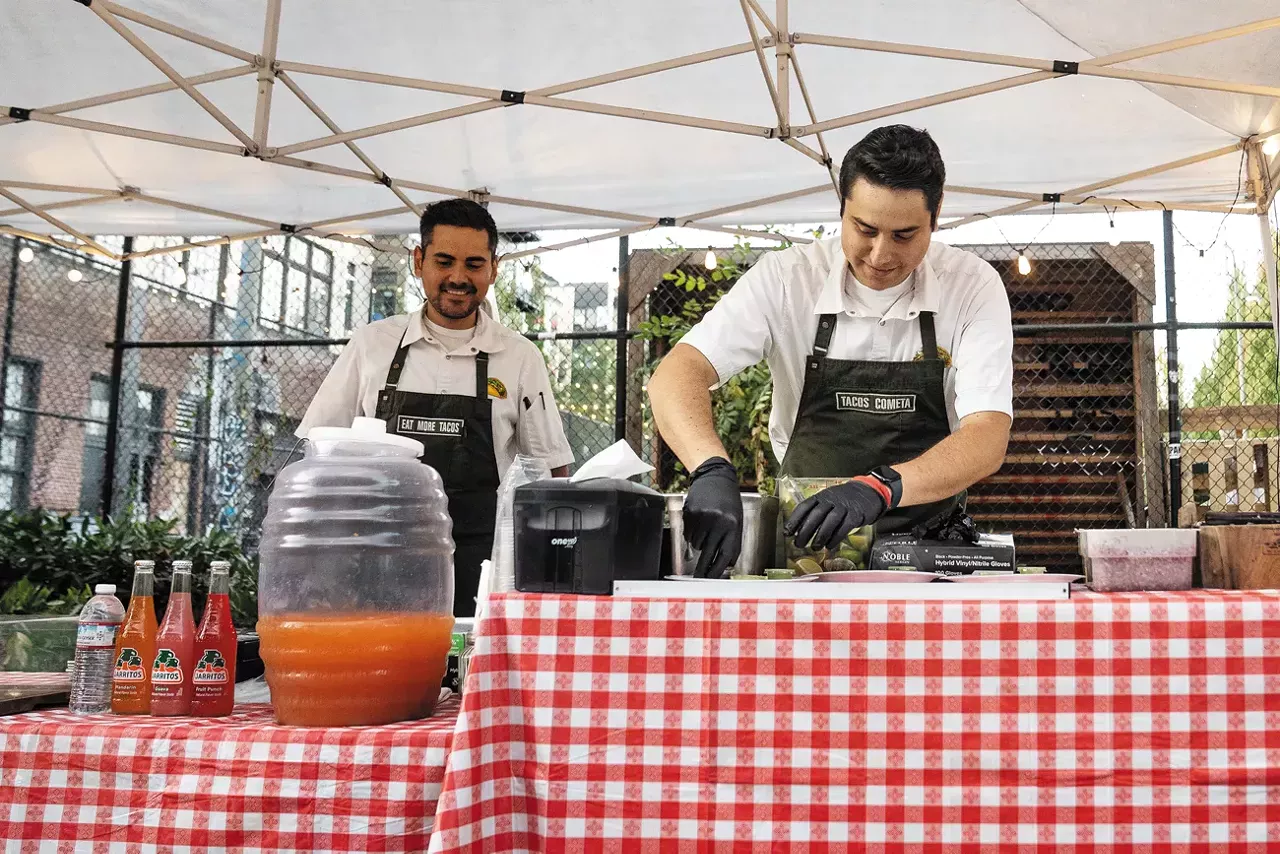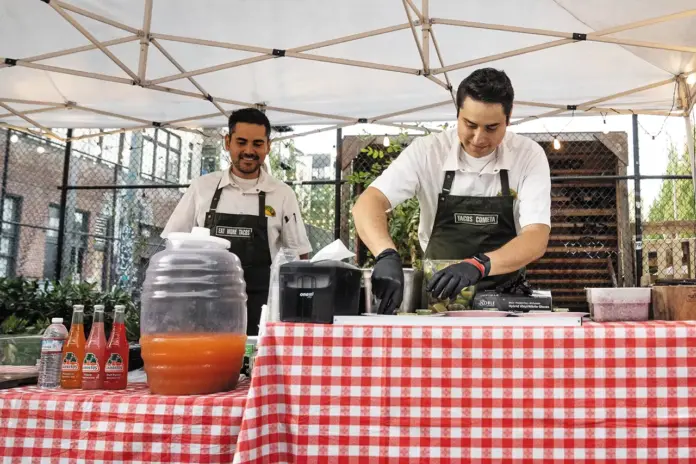This post was originally published on this site
If you’re near the southwest corner of Cal Anderson on a Saturday night, you might catch a whiff of the smoky aroma of charcoal-grilled beef.
Follow that scent and you’ll find brothers Osiel and Reynaldo “Rey” Gastelum behind the grill of their taco stand, Tacos Cometa, serving Sinaloan-style carne asada tacos that you can’t find anywhere else in the city, heaped with chopped red onion, cabbage, and tomato salsa, and served with a cold wedge of cucumber.
Hungry regulars congregate beneath a white tent lit by string lights, as beef sizzles on the flat-top and Osiel deftly chops cooked meat on a wooden cutting board with a cleaver.
You might not know it, but those tacos are the end result of a decades-long journey that started with home cooking in Sinaloa, Mexico, with stops at some of the world’s most exclusive three-Michelin-starred restaurants along the way.
Rey and Osiel spent their early years in Culiacán, the capital of Sinaloa, surrounded by an abundance of seafood and produce. Their parents, who were generous hosts and the best cooks in each of their respective families, routinely entertained on weekends, feeding friends and family “too much food.”
Some of Rey’s earliest food memories are of his parents making gigantic portions of barbacoa, which is traditionally made by slow-cooking meat until it falls apart in tender shreds and varies according to region. “Barbacoa in Sinaloa is a little bit different,” says Rey. “We use chilies to make a marinade with beef and a little bit of pork rib, and we would make huge batches of barbacoa. I remember as a little kid helping out and the smells that would come out of the kitchen. It just makes you hallucinate, it’s so good…The end result was magical to me, that transformation.”
Osiel recalls his dad, a dental technician with no restaurant experience, making “massive meals” with advanced techniques, including tacos de cabeza. “I remember him just coming home with this whole cow’s head and just steaming it,” he says.

Their parents passed their love of food to the next generation. Rey went to culinary school in Orange County, and Osiel, who is two years younger, attended cooking school at Universidad Autónoma de Durango’s Sinaloa campus. After graduation, Rey moved to San Sebastián to train at the three-Michelin-star restaurant Martín Berasategui. He returned to the US to work for the high-end Italian restaurant Acquerello in San Francisco, then spent seven years in Paris at esteemed institutions like Le Gabriel and Marsan by Hélène Darroze, and serving as sous chef at the historic Michelin-starred restaurant, Hugo Bourny at Lucas Carton.
Osiel spent a few years after school working in some of the best restaurants in the Bay Area. In 2016, he joined the team at famed chef Dominique Crenn’s three-Michelin-starred flagship Atelier Crenn and worked his way up the ranks from commis to sous chef. Over the next few years, he worked under Aitor Zabala at Somni in Los Angeles, developed his butchery skills at Curtis Stone’s steakhouse Gwen, and became the chef de cuisine at Stone’s restaurant Gwen.
With years devoted to the culinary grind, both brothers decided that they wanted to start a formal sit-down restaurant of their own. The two scouted multiple locations, including Florida and Texas, and eventually landed on Seattle, because of its high-quality seafood and produce and the changing seasons. On a research trip in September, they tried a taco in Seattle and came up with the idea to start a taqueria instead, realizing they could offer a product unlike anything else in the area. They wanted to pay tribute to the regional tacos they grew up with at their favorite stand in Sinaloa, which are charcoal-grilled and feature the aforementioned finely chopped cabbage and red onion. Rey says the goal is to “make Seattle known for amazing tacos, to put it on the map along with LA.”
“Cometa” means “comet” in Spanish: they’re “rare,” “bright,” and “unforgettable,” which is the experience Rey and Osiel want people to have when they try their food. The menu is straightforward: tacos, quesadillas, vampiros (a popular Sinaloan street snack with an open-faced, griddle-toasted corn tortilla, layered with melty cheese and taco fillings), and aguas frescas. And if you’re lucky, you might catch them on a day they offer alfajores, melt-in-your-mouth sandwich cookies filled with dulce de leche.
The brothers are constantly tasting the food and adjusting the seasoning, working off their experience and memories. “We focus on simplicity. We don’t overcomplicate it,” says Rey. “Our meat, for example, there’s no marinade. What we do is have really good quality meat and the charcoal and the love and the time. This is what makes it a good taco.”
Osiel believes that a Michelin-starred kitchen is not as different from a taco stand as one might think. He uses similar techniques and has learned from fine-dining to focus on restraint. “It’s the attention to detail,” he says. “You can have the exact same ingredients at both restaurants, but if you focus on the different details, you’re going to have a different result.”
Rey and Osiel are in lease negotiations for a storefront not far from their spot at Cal Anderson and hope to open a permanent location by March 2026. They just launched a crowdfunding campaign on Kickstarter, with incentives for supporters that include salsa packages, merch, cooking classes, three-course meals in your own home, and a private taco party. In the meantime, find the taco stand on Fridays in Fremont, and Saturdays at Cal Anderson.
The brick-and-mortar menu will be largely the same, possibly with some rotating specials, such as a taco with pescado zarandeado, based on their dad’s recipe—butterflied red snapper coated with a blend of mayonnaise, soy sauce, and butter, then grilled over charcoal. Rey says they aren’t sure yet whether they will have access to an oven, but that they will try their best to offer the alfajores, even if that means baking them in a different kitchen. The vibe will be “minimal” and unpretentious, to maintain the feeling of a street taqueria.
At times, navigating the hurdles of Seattle’s health department laws has proved a challenge. However, counter to any stereotypes about the Seattle freeze, Osiel and Rey say they’ve encountered only warmth and kindness from the city’s chefs and restaurateurs. “There’s been a huge sense of community,” Rey says. “It seems like people are there to help and not screw you over.” Chefs at local restaurants Driftwood and Le Coin contributed guidance and leads for purveyors, while others have shared tips on navigating the process of opening a restaurant. Chef Keiji Tsukasaki of LTD Edition Sushi, located near Tacos Cometa, even once bought a round of tacos for his restaurant as the last course of his omakase menu and regularly orders tacos for his staff toward the end of their shifts. “That feels pretty special, to have a connection with someone who’s doing something super cool in Seattle and have them validate you,” Osiel says.
Since opening in late December 2024, Tacos Cometa has attracted a loyal following, with some fans attending religiously nearly every day they’re open. “Nothing makes me happier than just standing at the taco stand, watching someone take the first bite and smile,” says Rey.
As for their food-loving family, they couldn’t be more proud. Their parents traveled from Culiacán to visit and beamed when they tried their sons’ tacos—especially their dad, who’s harbored a hidden dream of opening a taqueria all his life. He was less than impressed by a multi-course tasting menu at a prestigious restaurant managed by Osiel last year, but a few hours after getting off the plane to Seattle, he was hanging out behind the stand, manning the grill.
“When we got into fine dining, he didn’t really understand it. He was always like, just stop doing that and open a taco shop or a skewer shop or something like that,” says Osiel. “So I think now that he sees us doing a taco shop, he’s super excited about it, because it’s something that he understands, something that he can contribute to.”
“He’s seen us working in Michelin-starred restaurants and working with amazing chefs,” says Rey, laughing. “It’s like, no. Now we’re proud of you.”




















